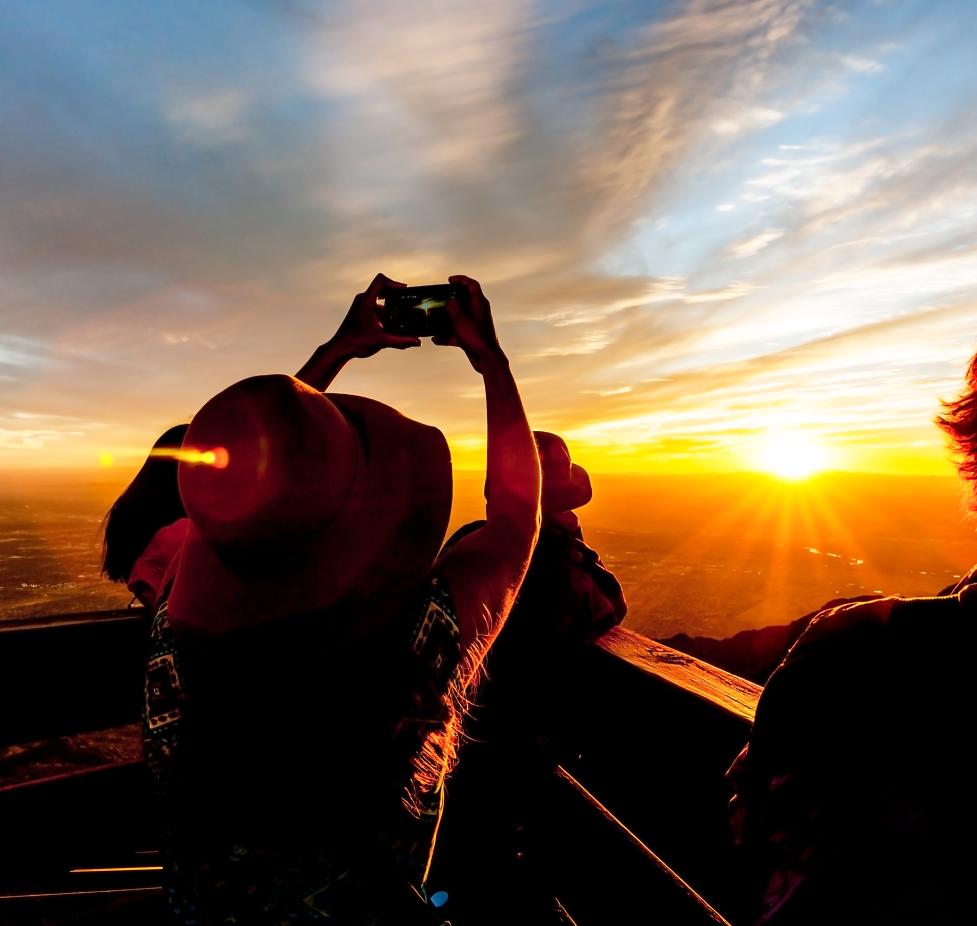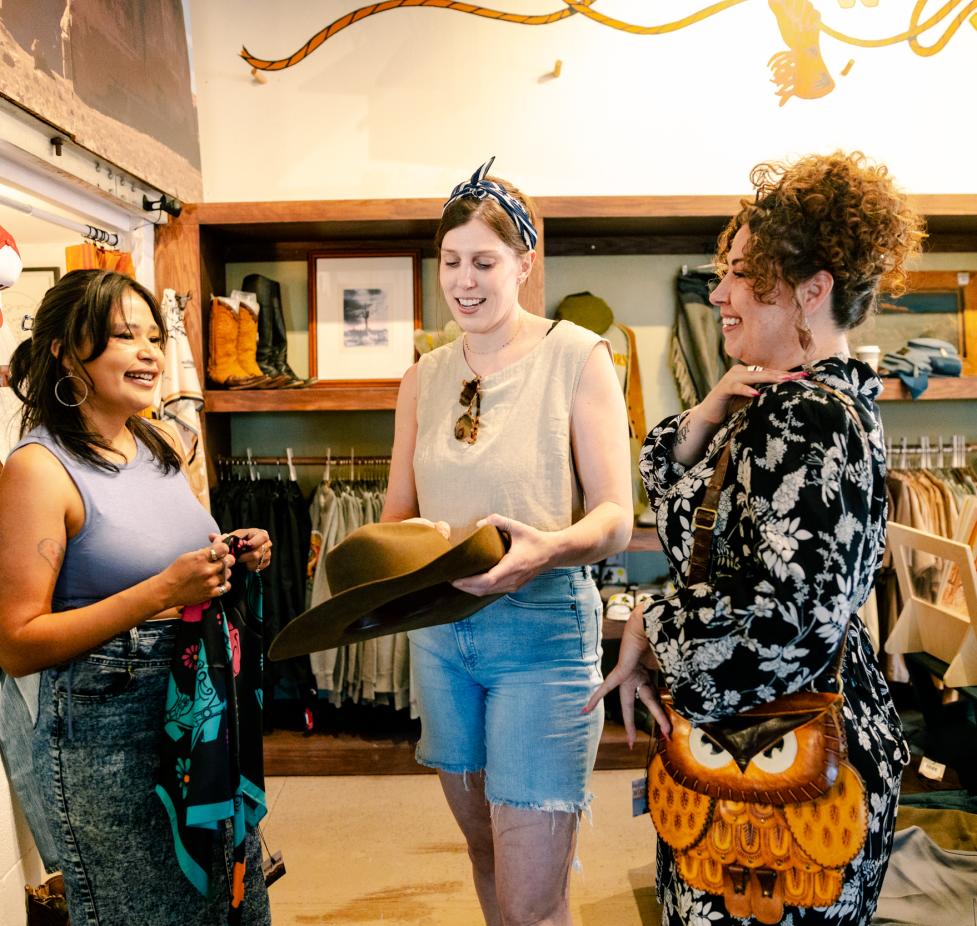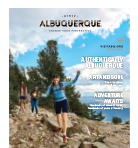Visit Albuquerque prohibits users from downloading images from our website.
Please use our media library for downloadable images and usage rights.Media Kit
Culture, Heritage, and History
Recognized as one of the most culturally diverse cities in the country, Albuquerque’s ethnic tapestry is reflected in its architecture, artwork, cultural centers and cuisine. Countless customs and traditions passed down over generations are a vibrant part of daily life in the city, and make Albuquerque a center of authentic Southwestern culture.
Discover the rich art and culture, rooted in centuries of history, expressed through Native American pottery and jewelry, and Southwestern paintings. The influence of Native American, Spanish and Western heritage is clear. It’s in the Pueblo and Spanish-inspired architecture. It’s in the world famous cuisine, the music and the art. But most of all, it’s in the people – evident in the tremendous Southwestern hospitality.
Albuquerque History
Albuquerque, New Mexico’s largest city, was named to honor a Spanish Duke, the 10th Duke of Alburquerque, Spain. Colonial Governor Don Francisco Cuervo y Valdez selected the name, but over the centuries, the first “r” has been dropped. In 1706, Albuquerque was founded by a group of colonists who had been granted permission by King Philip of Spain to establish a new villa (city) on the banks of the Rio Grande (which means big or great river). The colonists chose a place along the river where it made a wide curve providing good irrigation for crops and a source of wood from the bosque (cottonwoods, willows and olive trees) and nearby mountains. The site also provided protection and trade with the Indians from the pueblos in the area.
The early Spanish settlers were religious people, and the first building erected was a small adobe chapel, San Felipe de Neri. Its plaza was surrounded by small adobe homes clustered close together for mutual protection against any threats posed by hostile forces in this vast and dangerous country. In 1792, the church collapsed under heavy rains and was rebuilt the following year. Since then, the building has undergone additional renovations. It has been enlarged several times and remodeled, but its original thick adobe walls are still intact. The church is the hub of historic Old Town, the sentimental heart of Albuquerque, with activity revolving around shopping and dining. To this day, special holidays and feast days are still commemorated as part of the year-round attractions of this “original” Albuquerque.
The growth of Albuquerque can be traced to two changes in the early development of the area. First, the Rio Grande changed course moving a little farther to the west, causing a slight shift in the population. Second, the railroad came to Albuquerque in 1880, and a “New Town” grew along the tracks two miles east of Old Town. Population increases can also be attributed to Albuquerque becoming an important stop on the Camino Real - the trail from Chihuahua to Santa Fe - and the city’s proximity to the Santa Fe Trail, the Southwest’s first “superhighway” during the westward expansion.
Between 1850 and 1875, many forts were established in the Southwest to protect the westward migration. Albuquerque was a major supply center to these forts. During this same period, merchandising companies that had first shipped goods by covered wagon, and then by rail, established warehouses and stores in Albuquerque. Manufactured goods from the east were brought in and hides, pelts, livestock, lumber and minerals were shipped out.
Albuquerque never went through the lawless days of the frontier like other western towns. When those times came (the last quarter of the 19th century), Albuquerque already had an established culture of a century-and-a-half old. Much of Albuquerque’s appeal today can be attributed to the subtle blending of the many cultures that comprise its fabric: American Indian, Spanish, Anglo, African and Asian. Each has left its mark in food, music, religion, art, customs, architecture and traditions.
Historic Route 66 weaves through Albuquerque connecting our past, present and future. Albuquerque grew up along Route 66, and it continues to measure the pulse of the city, connecting popular attractions on what is now Central Avenue. Beginning with Petroglyph National Monument on the city’s far west side, modern day adventurers will pass through the Rio Grande Botanic Garden and the Albuquerque Aquarium, historic Old Town, the Albuquerque Museum and the New Mexico Museum of Natural History & Science. Walking or driving through the downtown area, visitors enjoy the majesty of the KiMo Theatre and the ambiance of diners and restaurants along a revitalized Route 66. Route 66 passes by the University of New Mexico, farther east, and the trendy Nob Hill area which is home to many of the city’s best restaurants and many eclectic shops and boutiques.
Albuquerque stands with one foot in the past, one foot in the present and both eyes on the future. Home to some of the nation’s finest high-tech research facilities including Sandia National Laboratory, Phillips Laboratory and the University of New Mexico, Albuquerque is leading the way in technology transfer. Companies including Intel, Eclipse Aviation, and Advent Solar call Albuquerque home. Civilian application of military technology has provided the spark for many an entrepreneur and led to a technological boom. Albuquerque continues to set the pace for success throughout the Southwest as both a visitor destination and a great place to live.
For more information see Uniquely Albuquerque: Centuries of History
CULTURAL CENTERS
National Hispanic Cultural Center
The National Hispanic Cultural Center (NHCC) is the only national cultural institution dedicated to the study, advancement and presentation of Hispanic culture, arts and humanities. NHCC offers both permanent and traveling exhibits that showcase visual arts, performing arts, history and literary arts, media arts and education. The center is also home to a restaurant as well as indoor and outdoor performing arts spaces. At the entrance to the NHCC is the Torreón Fresco, a massive fresco depicting the cultural development of Hispanic heritage from prehistory to present day. Internationally renowned artist and New Mexico native Frederico Vigil created the painting in 2010 in the ancient “fresco” technique. It is open to the public on Sundays from 12-4pm or by special request. (505) 246-2261 www.nhccnm.org
Indian Pueblo Cultural Center
Located minutes away from historic Old Town, the Indian Pueblo Cultural Center is dedicated to the preservation and perpetuation of Pueblo Indian culture, history and art. The museum displays feature the Pueblo Indian cultures from prehistoric to modern times through a variety of fascinating exhibits and artifacts and represents all 19 pueblos found in New Mexico. The center also features the only Native American-owned restaurant in Albuquerque, which serves meals throughout the day and special weekend brunches accompanied by performances. (866) 855-7902, (505) 843-7270 www.indianpueblo.org
Sky City Cultural Center
The Sky City Cultural Center and Haak’u Museum strive to preserve Native American traditions while providing insight into the unique history of the Acoma Pueblo Indians. The cultural center offers guided tours, Acoma pottery and Native American crafts for sale by local artisans, cultural exhibits, and a host of performances and events. (800) 747-0181 www. acomaskycity.org
South Broadway Cultural Center
South Broadway Cultural Center is a multicultural, visual, performing and literary art center that promotes, preserves and educates the community about the cultures and ethnicities that define Albuquerque. (505) 848-1320www.cabq.gov/sbcc
African American Performing Arts Center
Located at Expo New Mexico, the center is used for music, theatre, special presentations and dance performances. The exhibit hall houses permanent and traveling art exhibits. The center provides public education programs on the history, culture and arts of people of African descent. (505) 222-0777 http://www.aapacnm.org
Albuquerque Museum of Art & History
The Albuquerque Museum of Art & History, located in the heart of historic Old Town, features art of the Southwest as well as 400 years of Albuquerque history and the Rio Grande Valley through permanent displays and traveling exhibitions. (505) 243-7255 www.cabq.gov/museum
For additional information about our unique culture, visit www.visitalbuquerque.org/culture.
HISTORIC ATTRACTIONS
Historic Old Town
There is a treasure trove of history hidden near the center of modern Albuquerque. This “Original Albuquerque” began 70 years before the American Revolution (1706) when King Philip of Spain gave colonists permission to settle an area of the Rio Grande Valley known today as Old Town. This area, now a historic zone, looks much like it did centuries ago. The picturesque plaza serves as the epicenter for activities and events. San Felipe de Neri, the historic church in Old Town, known as the “Corazon de Albuquerque” (heart of Albuquerque), was the first building constructed in the square. Settlers built their homes, shops and government offices around the plaza. The Pueblo-Spanish style architecture, characterized by the use of adobe, makes Old Town a beautiful place to visit. The flat-roofed buildings and their soft contours mirror the Southwestern landscape. Long portals (porches) line the fronts of most buildings while bancos (benches) are often found built into the back walls of portals so that weary bones can be soothed by the sight of a Southwestern sunset. A wide variety of Southwestern artwork is available in the area including jewelry, sculptures, paintings, weavings and handcrafted work. Old Town is home to more than 150 stores, 35 galleries, five museums and of course, delicious New Mexican-style dining. www.albuquerqueoldtown.com
Petroglyph National Monument
On Albuquerque’s west side, you will find the Petroglyph National Monument. More than 20,000 ancient Indian petroglyphs are carved into the black rock remnants of five extinct volcanoes. This monument is home to the world’s largest accessible collection of petroglyphs. These petroglyphs were carved by the ancestors of today’s Pueblo people, other Native American groups and Spanish settlers; from 1300 to 1650. Dancers, shamans, mythic creatures, clan symbols and a variety of animals all portray a way of life richly steeped in religion and ceremony. A variety of trails accommodate a range of visitors. (505) 897-8814 www.nps.gov/petr
Sports & Outdoor
The city of Albuquerque sits at a mile above sea level (5,000-6,000 ft. elevation) and has a high-desert... More
Family Fun & Games
Albuquerque has fun for all ages, see our family fun page to learn more! More
Specials and Coupons
Looking for discount hotel rates in Albuquerque, New Mexico? Albuquerque is home to legendary... More







